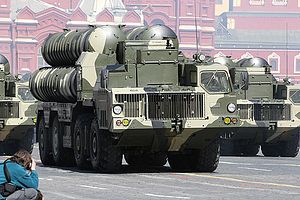Russia has delivered the first battalion of S-300PMU-1/SA-20 Gargoyle surface-to-air missile (SAM) batteries to Iran, Russian presidential aide for military-technical cooperation Vladimir Kozhin revealed in Moscow this week, according to TASS.
“The first batch – about one battalion – has been shipped. We will comply with our liabilities by the end of the year,” Kozhin said, adding that the rest of the S-300 missile defense systems, due under the effective contract, would be supplied by year’s end.
It is unclear how large Iran’s S-300 battalions will be and what type of missiles Russia is supplying for the launchers. The head of the Russian federal service for military-technical cooperation Alexander Fomin refused to reveal the exact number of units already shipped to Iran, last week.
The S-300 is a long-range surface-to-air missile system, and can engage aircraft, cruise missiles and theater ballistic missiles. One S-300 battery usually consists of an engagement radar, a low-altitude radar, and up to eight transporter erector launchers (TEL) with four launch tubes each. Each tube carries one surface-to-air missile. A battalion comprises up to six batteries in addition to a command/fire and control post, as well as an extra target acquisition radar unit.
During Iran’s annual National Day Parade in April, the Iranian military displayed a S-300 target acquisition radar unit, a radar station and a mobile radio antenna. However, no TELs and missiles were displayed. As I reported previously:
The S-300 SAMs currently being delivered are an upgraded version of the weapons systems initially ordered by Iran in 2010. In July 2015, Russian Presidential Aide Vladimir Kozhin announced that Russia would update the S-300 SAMs to meet specific Iranian needs without, however, offering technical details.
Russia was forced to cancel the delivery of the weapons in June 2010 due to a United Nations Security Council resolution imposing sanctions — which included a ban on the sale of hi-tech weapons. After the cancellation of the arms deal, Iran demanded $4 billion in compensation from the Russian state.
Alexander Fomin also recently stated that Russia does not plan to sell tanks to Iran, according to TASS. “Such deals might be possible only when the bans are gone. Tanks, ships, missiles and other attack weapons fall under UN sanctions,” he said. He also explained that Russia is not working on any “absolutely new” weapons contracts with Iran.
In February, Russia purportedly offered to license-produce third-generation T-90s main battle tank and Sukhoi Su-30 multirole fighter aircraft in Iran, causing the United States to issue a statement saying that it would block any such sales.
































